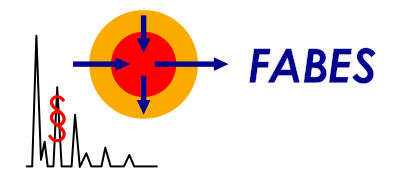Software
Software programs can provide valuable services in compliance work. However, our programs also show their strength when a problem can no longer be solved analytically!
A few examples that FABES has been able to model in various projects are intended to show what possibilities for estimation already exist:
- Migration (“single use” and “repeated use”) of a substance from monolayer and multilayer plastic packaging or paper packaging; objective: e.g. to confirm migration limits;
- Migration of a substance from a drinking water pipe material into (non-) flowing water (“single use” and “repeated use”). KTW guideline and DIN EN 12873–1:2014 can be taken into account; aim: among others, to confirm migration limits;
- Migration of a substance from a plastic material embedded in concrete; objective: confirmation of migration limits;
- Migration of a substance from plastic pipes, roof tiles, window frames or recycled plastics in rainwater; aim: estimation of environmental impact;
- Accident migration analysis: a transporter with a loaded “hazardous substance” has an accident, whereby the transported goods fall into a nearby body of water; objective: estimation of the environmental impact;
- Migration of a substance from a garment (incl. further risk assessment for wearing the garment – consideration of a film of sweat or suntan lotion on the skin); aim: estimation of exposure;
- Modelling of the permeation of gases by special matrices using the example of a membrane for regulators used in breathing apparatus for the fire brigade.
Do you have a specific problem, but can’t find it in our presented solutions? Then please contact us. We may already have a program ready that we can use for you! In principle, it is also possible to develop a new program tailored to you in order to assess the migration in the system “material – contact medium”.
It has been scientifically proven that the migration of substances such as additives, slip agents, oligomers, residual monomers, stabilisers, photoinitiators, plasticisers, etc. from plastic materials as well as from paper and cardboard into different contact media, e.g. food, drinking water, air or soil, can be calculated with suitable theoretical models. Basically, each model is based on the solution of specific mathematical equations taking into account migration conditions (time/temperature) and the input of data and parameters reflecting the nature of the contact material-contact medium system.
For the food packaging sector, it was already stipulated in the EU Plastics Directive 2002/72/EC that compliance with specific migration limits (SMLs) can be tested and proven by applying scientifically recognised diffusion models. This was taken over in the European Plastics Regulation (EU) No 10/2011 Annex V, §2.2.3 and expanded in content. A detailed “Practical Guideline” document on this Annex, which provides detailed help and guidance on in which cases and in which way migration modelling has to be performed for the compliance test of a plastic food packaging, was published in 2015 by JRC-Ispra in cooperation with the EU Commission.
The FDA is also aware of the benefits of such programs, which is why it allows the use of software programs for estimating migrations in accordance with the “Guidance for Industry – Preparation of Premarket Submissions for Food Contact Substances: Chemistry Recommendations”.
FABES had essentially participated in the early stages of the consultations and work that led to these legal requirements. Under the coordination of Dr Piringer, the scientific basis and data for the migration estimation within the framework of the Plastics Directive 2002/72/EC were elaborated around the turn of the millennium. At the same time, the user-friendly software MIGRATEST© LITE was developed at FABES, which enabled users to calculate migration from monolayer plastic materials and use it for compliance testing, as recommended by the aforementioned directive. FABES was involved as a consulting expert in the preparation of the above-mentioned “Practical Guideline” document.
In addition, FABES developed the user-friendly commercial software MIGRATEST© EXP more than 10 years ago. This program enables the estimation of the migration of substances from both mono- and multilayer packaging into real food and food simulants – “set-off” effects can be taken into account.
The estimation of migration when plastics come into contact with drinking water was recognised as a test method by the German Federal Environment Agency (UBA) within the framework of the “Guideline for the mathematical estimation of migration of individual substances from organic materials into drinking water (modelling guideline)” – October 2008. FABES was involved in the consultations and work that led to the drafting and adoption of this guideline. In connection with this guideline, the software MIGRAPIPE© was developed at FABES. Currently, FABES is involved in the revision of the above guideline with the aim of bringing this document up to date with the current state of knowledge and at the same time making it a practical reference for the user of migration modelling in drinking water.
Substances used in industry that may endanger human health or the environment are the main subject of Regulation (EC) No 1907/2006 (REACH Regulation). In this context, the migration of such substances from plastics and other materials in various industrial contact media (soil, technological liquids, circulating air, etc.) or into the human body is also an important aspect. Such migration processes can also be theoretically estimated with suitable models. In the short descriptions of MIGRATEST© XTR, MIGRATEST© SKN and MIGRATEST© SPH you will learn more.
At FABES, software programs have also been developed in recent years that enable migration calculations for scenarios that are not derived from a legal specification (regulation, directive, recommendation of guideline). These software programs serve research and development tasks in particular or can be used to solve very specific migration problems. These are the software programs MIGRATEST© RU, MIGR-DISTRIBUTION, SIMAQUA F and MIGRATEST© DDX. Further information can be found in their short descriptions.
Contact us and benefit from the in-depth knowledge of the FABES team and our comprehensive databases.
